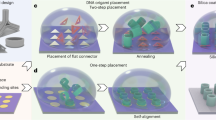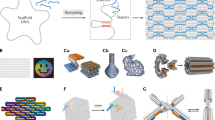Abstract
Molecular self-assembly with nucleic acids can be used to fabricate discrete objects with defined sizes and arbitrary shapes1,2. It relies on building blocks that are commensurate to those of biological macromolecular machines and should therefore be capable of delivering the atomic-scale placement accuracy known today only from natural and designed proteins3,4. However, research in the field has predominantly focused on producing increasingly large and complex, but more coarsely defined, objects5,6,7,8,9,10 and placing them in an orderly manner on solid substrates11,12. So far, few objects afford a design accuracy better than 5 nm13,14,15,16, and the subnanometre scale has been reached only within the unit cells of designed DNA crystals17. Here, we report a molecular positioning device made from a hinged DNA origami object in which the angle between the two structural units can be controlled with adjuster helices. To test the positioning capabilities of the device, we used photophysical and crosslinking assays that report the coordinate of interest directly with atomic resolution. Using this combination of placement and analysis, we rationally adjusted the average distance between fluorescent molecules and reactive groups from 1.5 to 9 nm in 123 discrete displacement steps. The smallest displacement step possible was 0.04 nm, which is slightly less than the Bohr radius. The fluctuation amplitudes in the distance coordinate were also small (±0.5 nm), and within a factor of two to three of the amplitudes found in protein structures18.
This is a preview of subscription content, access via your institution
Access options
Subscribe to this journal
Receive 12 print issues and online access
$259.00 per year
only $21.58 per issue
Buy this article
- Purchase on Springer Link
- Instant access to full article PDF
Prices may be subject to local taxes which are calculated during checkout




Similar content being viewed by others
References
Seeman, N. C. Nanomaterials based on DNA. Annu. Rev. Biochem. 79, 65–87 (2010).
Jones, M. R., Seeman, N. C. & Mirkin, C. A. Nanomaterials. Programmable materials and the nature of the DNA bond. Science 347, 1260901 (2015).
Gonen, S., DiMaio, F., Gonen, T. & Baker, D. Design of ordered two-dimensional arrays mediated by noncovalent protein–protein interfaces. Science 348, 1365–1368 (2015).
King, N. P. et al. Computational design of self-assembling protein nanomaterials with atomic level accuracy. Science 336, 1171–1174 (2012).
Rothemund, P. W. Folding DNA to create nanoscale shapes and patterns. Nature 440, 297–302 (2006).
Douglas, S. M. et al. Self-assembly of DNA into nanoscale three-dimensional shapes. Nature 459, 414–418 (2009).
Dietz, H., Douglas, S. M. & Shih, W. M. Folding DNA into twisted and curved nanoscale shapes. Science 325, 725–730 (2009).
Ke, Y., Ong, L. L., Shih, W. M. & Yin, P. Three-dimensional structures self-assembled from DNA bricks. Science 338, 1177–1183 (2012).
Gerling, T., Wagenbauer, K. F., Neuner, A. M. & Dietz, H. Dynamic DNA devices and assemblies formed by shape-complementary, non-base pairing 3D components. Science 347, 1446–1452 (2015).
Marchi, A. N., Saaem, I., Vogen, B. N., Brown, S. & LaBean, T. H. Toward larger DNA origami. Nano Lett. 14, 5740–5747 (2014).
Kershner, R. J. et al. Placement and orientation of individual DNA shapes on lithographically patterned surfaces. Nature Nanotech. 4, 557–561 (2009).
Gopinath, A. & Rothemund, P. W. Optimized assembly and covalent coupling of single-molecule DNA origami nanoarrays. ACS Nano 8, 12030–12040 (2014).
Bai, X. C., Martin, T. G., Scheres, S. H. & Dietz, H. Cryo-EM structure of a 3D DNA-origami object. Proc. Natl Acad. Sci. USA 109, 20012–20017 (2012).
Zhang, Z. et al. A DNA tile actuator with eleven discrete states. Angew. Chem. Int. Ed. 50, 3983–3987 (2011).
Kato, T., Goodman, R. P., Erben, C. M., Turberfield, A. J. & Namba, K. High-resolution structural analysis of a DNA nanostructure by cryoEM. Nano Lett. 9, 2747–2750 (2009).
Tian, C. et al. Directed self-assembly of DNA tiles into complex nanocages. Angew. Chem. Int. Ed. 53, 8041–8044 (2014).
Zheng, J. et al. From molecular to macroscopic via the rational design of a self-assembled 3D DNA crystal. Nature 461, 74–77 (2009).
Henzler-Wildman, K. & Kern, D. Dynamic personalities of proteins. Nature 450, 964–972 (2007).
Douglas, S. M. et al. Rapid prototyping of 3D DNA-origami shapes with caDNAno. Nucleic Acids Res. 37, 5001–5006 (2009).
Castro, C. E. et al. A primer to scaffolded DNA origami. Nature Methods 8, 221–229 (2011).
Scheres, S. H., Nunez-Ramirez, R., Sorzano, C. O., Carazo, J. M. & Marabini, R. Image processing for electron microscopy single-particle analysis using XMIPP. Nature Protoc. 3, 977–990 (2008).
Förster, T. Zwischenmolekulare energiewanderung und fluoreszenz. Ann. Phys. (Berlin) 437, 55–75 (1948).
Stryer, L. Fluorescence energy transfer as a spectroscopic ruler. Annu. Rev. Biochem. 47, 819–846 (1978).
Kalinin, S. et al. A toolkit and benchmark study for FRET-restrained high-precision structural modeling. Nature Methods 9, 1218–1225 (2012).
Doose, S., Neuweiler, H. & Sauer, M. A close look at fluorescence quenching of organic dyes by tryptophan. ChemPhysChem 6, 2277–2285 (2005).
Scheibe, G. Über die Veränderlichkeit der Absorptionsspektren in Lösungen und die Nebenvalenzen als ihre Ursachen. Angew. Chem. 50, 212–219 (1937).
Fasold, H., Klappenberger, J., Meyer, C. & Remold, H. Bifunctional reagents for the crosslinking of proteins. Angew. Chem. Int. Ed. Engl. 10, 795–801 (1971).
Kliche, W., Pfannstiel, J., Tiepold, M., Stoeva, S. & Faulstich, H. Thiol-specific cross-linkers of variable length reveal a similar separation of SH1 and SH2 in myosin subfragment 1 in the presence and absence of MgADP. Biochemistry 38, 10307–10317 (1999).
Green, N. S., Reisler, E. & Houk, K. N. Quantitative evaluation of the lengths of homobifunctional protein cross-linking reagents used as molecular rulers. Prot. Sci. 10, 1293–1304 (2001).
Li, X. & Liu, D. R. DNA-templated organic synthesis: nature's strategy for controlling chemical reactivity applied to synthetic molecules. Angew. Chem. Int. Ed. 43, 4848–4870 (2004).
Gartner, Z. J. et al. DNA-templated organic synthesis and selection of a library of macrocycles. Science 305, 1601–1605 (2004).
McKee, M. L. et al. Programmable one-pot multistep organic synthesis using DNA junctions. J. Am. Chem. Soc. 134, 1446–1449 (2012).
Di Fiori, N. & Meller, A. The effect of dye–dye interactions on the spatial resolution of single-molecule FRET measurements in nucleic acids. Biophys. J. 98, 2265–2272 (2010).
Acknowledgements
The authors thank C. Castro for preliminary work on this project and F. Praetorius for scaffold DNA preparations. The authors also thank S. Niekamp for technical assistance. This work was supported by a European Research Council starting grant to H.D. (GA no. 256270) and by the Deutsche Forschungsgemeinschaft through grants provided within the Sonderforschungsbereich SFB863, and the Excellence Clusters CIPSM (Center for Integrated Protein Science Munich) and NIM (Nanosystems Initiative Munich).
Author information
Authors and Affiliations
Contributions
J.J.F. performed the research. H.D. designed the research. J.J.F and H.D. analysed and discussed the data. J.J.F. and H.D. prepared the figures and wrote the manuscript.
Corresponding author
Ethics declarations
Competing interests
The authors declare no competing financial interests.
Supplementary information
Supplementary information
Supplementary information (PDF 13666 kb)
Supplementary Movie 1
Supplementary Movie 1 (MOV 1041 kb)
Supplementary Movie 2
Supplementary Movie 2 (MOV 8898 kb)
Rights and permissions
About this article
Cite this article
Funke, J., Dietz, H. Placing molecules with Bohr radius resolution using DNA origami. Nature Nanotech 11, 47–52 (2016). https://doi.org/10.1038/nnano.2015.240
Received:
Accepted:
Published:
Issue Date:
DOI: https://doi.org/10.1038/nnano.2015.240
This article is cited by
-
Storage of mechanical energy in DNA nanorobotics using molecular torsion springs
Nature Physics (2023)
-
Site-directed placement of three-dimensional DNA origami
Nature Nanotechnology (2023)
-
A temporally resolved DNA framework state machine in living cells
Nature Machine Intelligence (2023)
-
Functionalization and higher-order organization of liposomes with DNA nanostructures
Nature Communications (2023)
-
Programmable multispecific DNA-origami-based T-cell engagers
Nature Nanotechnology (2023)



